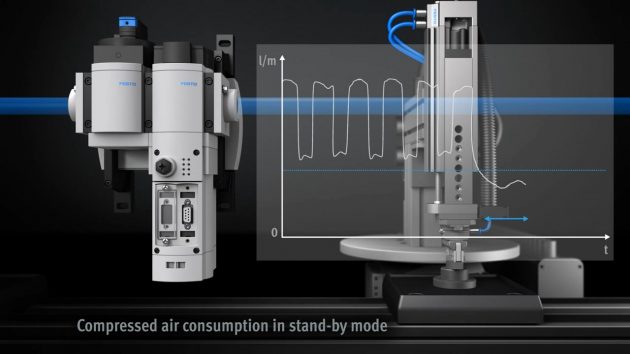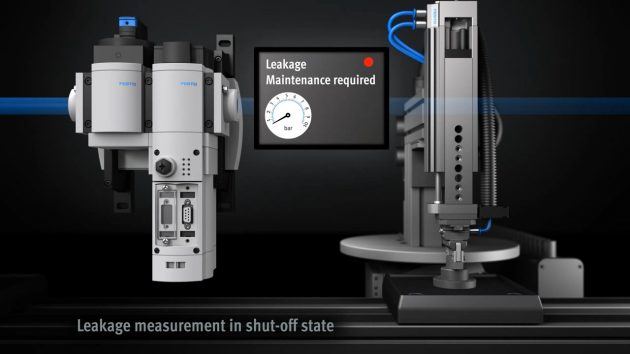
Compressed air is the most cost-effective energy source for driving many industrial processes – but leakage, invisible to the eye and generally inaudible to the ear except up really close, often negates much of the savings.
It’s constant waste, and it happens even in businesses with a strong focus on system maintenance. Estimates of compressor capacity loss run from 10-30 per cent. It usually starts with tiny trickles around joints or in hoses, and can grow into a major problem causing unscheduled downtime.
Want to see other articles on Automation? Click here to download our new Automation Handbook.
The conventional means for monitoring air loss are reactive, like relying on pressure sensors on air preparation units to alert the operator via a signal to the PLC or DCS that the pressure has dropped below the required operational level. At that point, the system reacts and often shuts down until engineering or maintenance diagnoses and fixes the problem.
However, measuring air pressure addresses only one factor. Air flow rates and volumetric consumption have been widely ignored, yet can point to problems or problematic trends well before they are serious enough to trigger an unscheduled shutdown. Festo’s intelligent MSE6-E2M energy efficiency module has changed the paradigm, enabling a proactive rather than reactive approach to air loss recognition. By continuously monitoring air flow, the -E2M serves as an early detection system for leaks, so repairs can be done when issues are small, and usually between cycles or during scheduled maintenance.
The -E2M, part of the newly expanded MSE6 series of energy efficiency modules, serves as both a pressure sensor and flow sensor, measuring the real-time air flow rate as well as the volumetric consumption over a defined period. This data can be used to reduce compressed air consumption on an on-going basis.
For instance, in a given manufacturing setting, the -E2M shows a specific, repeatable process is consuming 27 litres of compressed air per minute at standard atmospheric pressure. This establishes a baseline. Subsequently, it shows the same process consuming 33 litres per minute. Pressure measurement isn’t going to identify the existence of a problem unless the pressure level falls below operational minimums. However, in this example, the pressure is sufficient, but the process is inefficient because it now takes 33 litres of air per minute to maintain sufficient pressure, which means the compressor is working harder, at a cost.
 The -E2M also can perform leak checks downstream between cycles. The unit will pressurize the pneumatic circuit and measure pressure degradation to determine if air is leaking and at what rate. Furthermore, while the system is idle or shut down, the -E2M acts as a master on/off valve, preventing air loss through trickling.
The -E2M also can perform leak checks downstream between cycles. The unit will pressurize the pneumatic circuit and measure pressure degradation to determine if air is leaking and at what rate. Furthermore, while the system is idle or shut down, the -E2M acts as a master on/off valve, preventing air loss through trickling.
The -E2M is also notable among Festo’s MSE6 series for its ability to upload data to the cloud when connected to a Festo CPX IoT Gateway on a CPX electrical terminal. That enables simple traffic light indications, as well as graphic depictions of energy use, performance figures, and makes available historical data on standard predesigned dashboards. These dashboards can be securely accessed on any device with internet access.
The MSE6-E2M fits directly into existing air preparation and filtration units of both new and existing manufacturing equipment. The IoT Gateway module fits directly into valve terminals, the Festo I/O module, or a combination of both. Both products work over fieldbus, HMI, local networks, Festo cloud, and third-party clouds, and in unison to provide useful and meaningful data for optimal compressed air performance.
The MSE6-E2M can be incorporated into an existing system as a standalone unit, which is the simplest and most cost-effective approach. In this scenario, because it is not connected to the PLC or DCS, some benefits of the -E2M are not fully realized, like the ability to measure air loss between processes or the automatic air shutoff capability when the equipment is idle. But all the analytical tools are available to indicate leakage or deteriorating performance. It’s a risk-free way to evaluate data collection on operational efficiencies. There are no programming or commissioning changes required at the PLC/DCS.
Alternatively – and this is certainly the preferred approach with new designs or significant upgrades of the compressed air system – the -E2M can be integrated into the PLC/DCS. In this scenario, the full benefits are available, like the measurement of pressure changes during the idle state and automatic shutdown when the system is not in production or process. These are configurable parameters, accessible from the FB or AOI, that allow customization for process requirements. The HMI can also have access to all the energy and diagnostic data for local dashboards and fault handling.
For more information on the MSE6-E2M, click here: https://www.festo.com/cms/en-ca_ca/53452.htm?nmcmpid=35c47c74be471518606e27c391903cda
Read about one food company’s success story with the -E2M: https://www.festo.com/rep/en-ca_ca/assets/pdf/Unilever%20Story.pdf?nmcmpid=f0812059879adf2b55c31d4452323cba
To download a whitepaper on the E2M in the Life Science Sector – and how it might apply in your process business – click here: https://www.festo.com/cms/en-ca_ca/71302.htm?nmcmpid=a2d13ab18f10e53afde40eb7a17932b0
To view a video on the -E2M, click here: https://www.youtube.com/watch?v=qwVODlkhPr4
 The MSE6-E2M energy efficiency module provides alerts if it detects pressure dropping below prescribed limits while a process is in shutoff state. It likewise measures compressed air consumption for significant anomalies that suggest leakage.
The MSE6-E2M energy efficiency module provides alerts if it detects pressure dropping below prescribed limits while a process is in shutoff state. It likewise measures compressed air consumption for significant anomalies that suggest leakage.
When the MSE6-E2M is connected to the cloud via the Festo IoT Gateway device, data from the energy efficiency module is displayed on a standardized dashboard for easy monitoring and benchmarking. Trends can be analyzed, early warnings can be issued, and incident notifications can be set up. The Dashboards can be securely accessed in a web browser from any device with internet access.
www.festo.com
Print this page